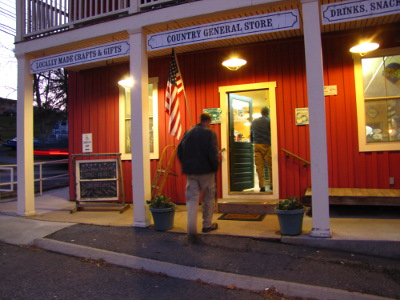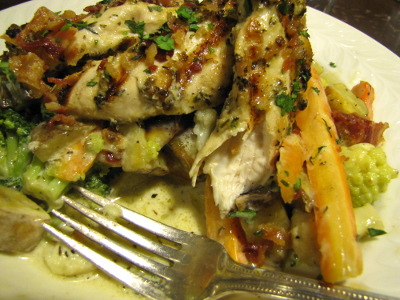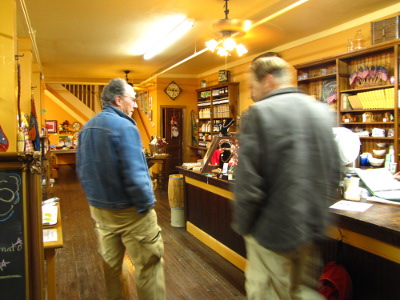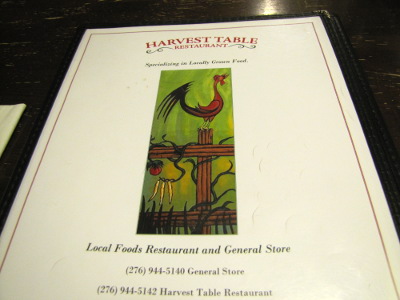
Harvest Table review
 Steve Hopp started the Harvest
Table Restaurant in
Meadowview, Virginia, based on the concepts outlined in his wife's
book, Animal,
Vegetable, Miracle.
The restaurant "work[s] with seasonal produce and meats from local and
regional sources, offering the best of each season."
Steve Hopp started the Harvest
Table Restaurant in
Meadowview, Virginia, based on the concepts outlined in his wife's
book, Animal,
Vegetable, Miracle.
The restaurant "work[s] with seasonal produce and meats from local and
regional sources, offering the best of each season."
In theory, the idea is
very sound, but in practice, this
article from July
2011 reports that the restaurant has yet to turn a profit. The
problem is pretty simple and is one of the first  things I noticed during our
recent visit --- price. Mark and I took our movie star neighbor
out on Saturday night and were a bit shocked that dinner for three (all
of us drinking water, but we did get two desserts and two starter
soups) came to $70, plus tip. In an area where the average annual
income is barely above the poverty line, a $28 meal is a hard
sell. (Yes, we always tip more than 15%. Mark has done his
time as a waiter and knows servers deserve it.)
things I noticed during our
recent visit --- price. Mark and I took our movie star neighbor
out on Saturday night and were a bit shocked that dinner for three (all
of us drinking water, but we did get two desserts and two starter
soups) came to $70, plus tip. In an area where the average annual
income is barely above the poverty line, a $28 meal is a hard
sell. (Yes, we always tip more than 15%. Mark has done his
time as a waiter and knows servers deserve it.)
 Our trip to the Harvest Table
was a thought-provoking lesson in practicing what we preach. I've
long said that if we bought our food from ethical sources --- pastured
meat and in-season produce raised by small farmers --- we'd be paying
twice as much for groceries. Realistically, that means eating out
half as often and cutting back on the pricey items (or growing them
ourselves.)
Our trip to the Harvest Table
was a thought-provoking lesson in practicing what we preach. I've
long said that if we bought our food from ethical sources --- pastured
meat and in-season produce raised by small farmers --- we'd be paying
twice as much for groceries. Realistically, that means eating out
half as often and cutting back on the pricey items (or growing them
ourselves.)
Unfortunately, that also
means leaving the poor out of the equation. I suspect that very
few locals eat at the Harvest Table and that the restaurant instead
gets most of its business from  tourists passing through on
the nearby I-81. I'm not sure what the solution is to that thorny
problem (except that gourmet food is one of the items we can all grow
with a little time and space.)
tourists passing through on
the nearby I-81. I'm not sure what the solution is to that thorny
problem (except that gourmet food is one of the items we can all grow
with a little time and space.)
For those of you who
live far away (or can't afford the high prices), the Harvest Table
could provide a simpler lesson. Keep an eye on their specials on facebook for ideas about cooking
totally in-season meals of your own. Or drop by the restaurant to
check out their selection of permaculture books and local crafts.
Want more in-depth information? Browse through our books.
Or explore more posts by date or by subject.
About us: Anna Hess and Mark Hamilton spent over a decade living self-sufficiently in the mountains of Virginia before moving north to start over from scratch in the foothills of Ohio. They've experimented with permaculture, no-till gardening, trailersteading, home-based microbusinesses and much more, writing about their adventures in both blogs and books.
Want to be notified when new comments are posted on this page? Click on the RSS button after you add a comment to subscribe to the comment feed, or simply check the box beside "email replies to me" while writing your comment.

I like your main point in this a whole lot. The Harvest Table prices are way too high for food of any kind.
I think they are right on in the idealism of eating local and preparing it slow. But they need to figure out how to include more of the down and out population.
We all are not farmers. And though the world might be much better if we were, we have a long way to go.
Maybe their prices would go down if more people were vocal about our lack of funds.
(PS I tip reasonably too.)
It's unfortunate that they're doing such a neat thing yet aren't able to turn a profit. I wonder how much the cost of the building and all the furnishings for the place contribute to the inability to make a profit. Maybe a model of this business done out of one's home might work considering the lower overhead with working out of ones home? I love their idea, I would really like to see it work.
Maggie, it's unfortunate that some people wouldn't be able to afford to eat in their restaurant. But considering they're already not making a profit, how can you expect them to lower their prices further? I can't afford a new truck, should Ford and GMC lower their prices to accommodate me and not make a profit?
If they can't make a profit then they won't be able to keep their doors opens or make a living. And I would be willing to bet they employee people that would like to keep their jobs.
Maggie --- That's what I've been trying to decide --- are their prices way too high, or are we just so used to corporate agriculture that we're not willing to pay how much food really costs? And if good food really costs that much, what can the poor eat?
Edward --- I know what you mean --- I ordered that exact dish while we were on the road last week and got exactly what you described. I think that in menu-speak "seasonal" means "we want you to think this is fresh" and has nothing to do with actual seasons.
Heath --- Smart ideas about thinking outside the box to make the food more available! I should have thought of that since that's basically the theme of our Microbusiness Independence ebook --- delete the physical storefront and you can lower prices and still pay yourself a living wage.
I was reading somewhere about a lot of people doing just what you said to sell good quality food on a small scale. I believe you can even get around dealing with all of the health department stuff if you are a private club instead of a public business.
Now I wish I could see a breakdown of their costs to see where all of the money goes.....
The green revolution enabled a large increase in yield for a lot of staple food crops.
One of the three main causes is cheap fertilizers made from and with with fossil fuel. (But it is estimated that improvement in irrigation and development of high-yield varieties were both equally important).
OK, I am going to go out on a limb here. I am not well versed in local farming so I will leave that to the experts. But I see a solution here on two fronts.
First, Anna didn't mention the author of that book is the best selling writer Barbara Kingsolver. And Anna is a writer too.
I wonder the correlation between local food growers, sellers and book sales. If people spent more money on good books like Barbara's and Anna's or my little chapbook (located in the Harvest Table store) that would put the money in the right hands!
Yes ma'am!
That the use of fossil-fuel based nitrogen fertilizers is not sustainable is something I'll readily agree to.
But I have to disagree that improving irrigation and breeding different varieties of crops that give more yield is inherently damaging to the environment.
Here in the Netherlands we've been managing water in one way or another for hundreds of years, out of bare necessity. (mostly to keep our feet dry ) Managing water can be done without harming the enviroment.
) Managing water can be done without harming the enviroment.
And trying to improve crops by breeding and selecting (i.e. exploiting essentially random variations) different varieties is also not something new. It's just done with science and a better understanding of genetics these days.
Maggie --- I actually mentioned Barbara Kingsolver in the first sentence of the post, but not by name --- just linked to one of her best-known books. I'm not sure I see how books are going to make food more affordable, though?
Joey --- There is a good range of prices at the Harvest Table, so you could get in and out pretty cheaply if you don't want vegetables. Mark's burger was $7, I think, which is definitely comparable with other places. On the other hand, my chicken carbonara was $19 (!!), maybe because it's tough to find pastured bacon?
We've eaten at Applebee's on our recent trip up to Ohio, and I'd agree with your forgettable assertion. The food is fine, especially if you ask to replace the potato side with some sort of vegetable, but it's true that the salads are iceberg (or maybe romaine) lettuce. Portion sizes are definitely larger, though, so I'd say you get about 3 to 4 times as much food per unit money at Applebee's as at the Harvest Table.
Roland --- Good point about irrigation and variety selection. (Although modern variety selection can cause problems since it tends to focus on single varieties over large areas, with the potential for potato-famine-like results. That's not directly related to the environment, though.)
I definitely don't want to just throw away all of the recent advances in agriculture, but I do think we need to analyze each "advance" to see if it really did send us forward instead of backward.
We could do better if we got used to the idea of working "hard" to just survive (stay warm, have enough to eat) rather than "get ahead". People go into business to make a profit, thinking that the more they invest in marketing, nice store, etc -- the higher or more likely a ROI. This is capitalism, which most people are realising, is defunct on a planet with finite resources. (Consider though, with 7 billion people, what seems not be finite -- human beings -- how scary is that when you consider what people will do in pursuit of "profit") The solutions are obvious -- less indivudual consumption and more individual restraint. Our biology (instincts, urges, emotions, fears) is so unevolved compared to our culture and technological capabilities -- we're on the path to self-destruction, or, to be more optimisitic, the evolution into something not quite / more than human.
human.
Lisa --- You sent me off on a thought tangent, so I'm going to reply in a long post tomorrow...
J --- Capitalism does make the value of food tricky to figure out. On the one hand, food is worth what the market will bear, which means 99 cents for a cheeseburger at McDonalds. On the other hand, the hidden costs of that cheeseburger are pretty severe, both to our health and to the environment. But even if we think capitalism has the cost of food wrong, I'm not sure what the solution is, short of economic collapse forcing people to grow their own food. After all, it's a lot easier to just buy that 99 cent cheeseburger....
Just wanted to add one more piece of food for thought on this topic. Restaurants in general are a pretty bad investment. The one year failure rate for new restaurants is about 25%. More than half fail within 5 years.
So it's entirely possible that their failure to turn a profit has nothing to do with their business model but the industry. I do recall hearing about similar restaurants elsewhere that were successful.